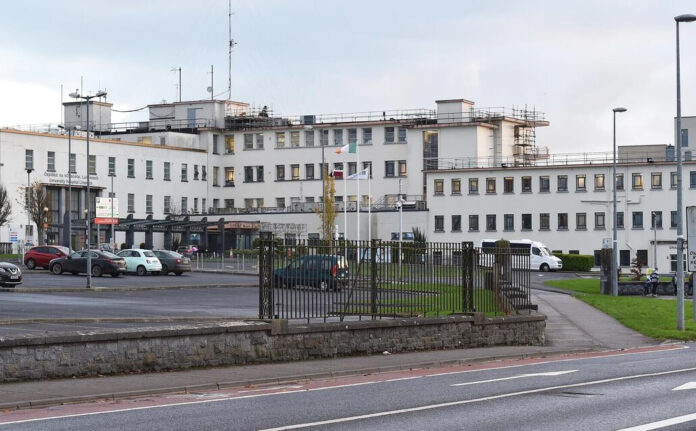
THE LATEST numbers from the Irish Nurses and Midwives Organisation (INMO) indicate that a total of 1,824 people were left waiting on trolleys in University Hospital Limerick (UHL) across July for in-hospital beds.
This equates to 556 more people being treated on trolleys and hospital corridors across last month than were treated during the same period last year, with figures showing it as the worst July on record for the chronically overcrowded Limerick hospital.
According to the Irish Nurses and Midwives Organisation’s TrolleyWatch figures, over 7,832 patients nationally, including 138 children, went without a bed in Irish hospitals this July.
In University Hospital Limerick, which was reported by this newspaper as being the most overcrowded hospital nationally for 50 consecutive days according to INMO’s figures, the figures for those waiting on trolley’s for in-hospital beds stood at 1,824 across the month of July. This represents a 43.8 per cent increase on July of last year, and a 601 per cent increase on this time 10 years ago in 2013.
In national context, UHL’s trolley figures for July put it at 196 per cent higher than the next most overcrowded hospital, Sligo University Hospital, and falling just short of the total for the entire eastern region at 1,898.
INMO Assistant Director of Industrial Relations for the Mid West and West, Mary Fogarty said over 23 per cent of patients on trolleys in July were treated just in University Hospital Limerick.
The level of persistent overcrowding, she added, is a serious concern for nurses at UHL.
“The volume of patients on trolleys at UHL this summer is excessively high in comparison to other acute hospitals nationwide,” Ms Fogarty said.
“Care is being compromised for patients in University Hospital Limerick because of severe nursing deficits, with over 48 vacant posts (35 per cent vacancy rate) in the Emergency Department.”
The INMO has warned that the HSE must view this as an indication of what “is now inevitable” this winter and act accordingly.
“The fact that we have seen over 7,832 patients on trolleys in July is a red flag warning for the autumn and winter ahead,” said INMO General Secretary Phil Ní Sheaghdha.
“The HSE must set out very clearly what measures it intends to take to reduce the levels of overcrowding in our hospitals in the coming months. This is a bleak sign heading into the winter months.
“It has been reported that the Cabinet has signed off on a year-round plan for the HSE, the INMO will be now seeking details of the staff support measures it contains, as staff cannot be expected to just endure these conditions for another winter.”
Reacting to the figures, Limerick Sinn Féin TD Maurice Quinlivan again called for the Government to address the increasing trolley numbers at UHL, pointing out the capacity challenges within the hospital as a “year-round problem”.
“Under the current government and this Minister for Health, the metrics have headed in one direction, the wrong direction. If the current figures continue, we will far exceed the numbers that were treated on trolleys last year, when over 18,000 people were treated on trolleys at University Hospital Limerick,” Deputy Quinlivan said.
“When we speak of trolley numbers, it is easy to get lost in the statistics. It is important to remember that each and every one of these numbers represent people. People who have had to present to hospital and must endure treatment without privacy or dignity.
“Previous spikes in numbers have been explained as winter surges, but we have these huge numbers in the middle of the summer. For one to be treated on a trolley in a hospital hallway is not good enough, for 1,824 to be treated on trolleys in one month is unacceptable.
“There is only so much our medical professionals can do when they are continually having to treat patients in conditions that are not appropriate. While the June HIQA report into UHL demonstrated that some of the concerns HIQA previously highlighted are being addressed, there continues a crisis of capacity.”
In response, a spokesman for UL Hospitals Group said that it has for a sustained period been managing significantly high numbers of patients presenting at UHL’s Emergency Department, including many frail, elderly, and other patients with complex care needs.
“Every day during the month of July, an average of 220 people attended the ED at UHL. This far exceeds the 195 daily attendances of 2019, which was the last full year prior to the Covid-19 pandemic. The shortfall in patient bed capacity at UHL has been repeatedly acknowledged by all parties, and remains the fundamental driver of hospital overcrowding.
“We continue to balance the needs of the most acutely ill patients on our emergency and urgent care pathways against the needs of our inpatients, and of patients waiting for scheduled care. All too often this can mean that admitted patients experience significant waits for a bed. This is not the standard of care we wish to provide for our patients, and we apologise to anyone who has been so impacted.
“Staff at all levels across UL Hospitals Group are working hard to reduce these wait times,” the ULHG spokesman concluded.


